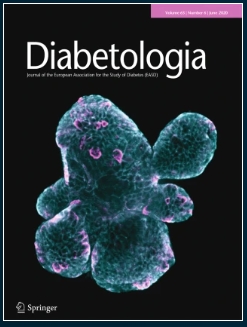bFGF rescues dysfunctional properties of adipose-derived stem cells from individuals with type 2 diabetes by modulating their miRNA profile.
IF 10.2
1区 医学
Q1 ENDOCRINOLOGY & METABOLISM
引用次数: 0
Abstract
AIMS/HYPOTHESIS The aim of this study was to investigate whether basic fibroblast growth factor (bFGF) can restore the proliferation and migration capacities of adipose-derived stem cells (ASCs), which are impaired by type 2 diabetes, and improve vascular remodelling. METHODS ASCs obtained from individuals with or without diabetes were cultured with 10 ng/ml bFGF for 9 days. The ASCs were phenotypically characterised and functionally tested for proliferation capacity. Differentially expressed miRNAs before and after treatment were analysed using miRNA arrays. Crosstalk between ASCs and human vascular smooth muscle cells (HVSMCs) was assessed using wound healing, transwell migration and co-culture assays. Finally, a Matrigel plug assay in nude mice was used to evaluate the contribution of ASCs to neovessel formation. RESULTS bFGF treatment significantly enhanced the proliferation and migration of ASCs from individuals with type 2 diabetes (T2DM ASCs), and altered the expression of miRNAs associated with ASC proliferation. ASCs promoted HVSMC migration and, when co-cultured, facilitated tube-like structure formation. In vivo Matrigel plug assays revealed that bFGF treatment enhanced neovessel formation. Although both non-T2DM ASCs (ASCs from individuals without type 2 diabetes) and untreated T2DM ASCs stimulated angiogenesis, bFGF-treated subcutaneous and visceral T2DM ASCs promoted even greater neovessel formation. Additionally, bFGF treatment modulated the expression of multiple angiogenesis-related miRNAs in ASCs. CONCLUSIONS/INTERPRETATION Preconditioning T2DM ASCs with bFGF alters their miRNA profile, enhancing cell proliferation and their vascular remodelling potential. This strategy could improve the therapeutic utility of T2DM ASCs.bFGF通过调节2型糖尿病患者的miRNA谱来拯救脂肪来源干细胞的功能失调特性。
目的/假设本研究的目的是研究碱性成纤维细胞生长因子(bFGF)是否可以恢复2型糖尿病受损的脂肪源性干细胞(ASCs)的增殖和迁移能力,并改善血管重构。方法用10 ng/ml bFGF培养糖尿病患者或非糖尿病患者的sscs 9天。对ASCs进行表型表征,并对其增殖能力进行功能测试。使用miRNA阵列分析治疗前后差异表达的miRNA。通过伤口愈合、跨井迁移和共培养试验评估ASCs与人血管平滑肌细胞(HVSMCs)之间的串扰。最后,在裸鼠中采用Matrigel栓试验来评估ASCs对新血管形成的贡献。结果bfgf治疗显著增强2型糖尿病(T2DM) ASCs的增殖和迁移,并改变与ASCs增殖相关的mirna的表达。ASCs促进HVSMC迁移,当共培养时,促进管状结构的形成。体内基质塞实验显示bFGF处理促进了新血管的形成。尽管非T2DM ASCs(来自非2型糖尿病个体的ASCs)和未经治疗的T2DM ASCs都刺激了血管生成,但bfgf治疗的皮下和内脏T2DM ASCs促进了更大的新血管形成。此外,bFGF治疗可调节ASCs中多种血管生成相关mirna的表达。结论/解释:用bFGF预处理T2DM ASCs可改变其miRNA谱,增强细胞增殖和血管重塑潜力。该策略可提高T2DM ASCs的治疗效果。
本文章由计算机程序翻译,如有差异,请以英文原文为准。
求助全文
约1分钟内获得全文
求助全文
来源期刊

Diabetologia
医学-内分泌学与代谢
CiteScore
18.10
自引率
2.40%
发文量
193
审稿时长
1 months
期刊介绍:
Diabetologia, the authoritative journal dedicated to diabetes research, holds high visibility through society membership, libraries, and social media. As the official journal of the European Association for the Study of Diabetes, it is ranked in the top quartile of the 2019 JCR Impact Factors in the Endocrinology & Metabolism category. The journal boasts dedicated and expert editorial teams committed to supporting authors throughout the peer review process.
 求助内容:
求助内容: 应助结果提醒方式:
应助结果提醒方式:


